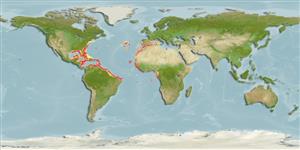Common names from other countries
Classification / Names / Names
आम नाम | उपशब्द | Catalog of Fishes (gen., sp.) | ITIS | CoL | WoRMS
Environment: milieu / climate zone / depth range / distribution range
पारिस्थितिकी
बेनथोपिलाजिक; गहराई सीमा 0 - 1200 m (Ref. 417). Tropical; 41°N - 9°S, 95°W - 11°E (Ref. 275)
Atlantic Ocean: from Straits of Gibraltar to western Africa and the Caribbean. Circumtropical.
Length at first maturity / आकार / वज़न / Age
Maturity: Lm ? range ? - ? cm Max length : 30.0 cm ML पुल्लिंग / अलिंग; (Ref. 104052)
Caught by squid jigs, dipnets, bottom trawls and midwater trawls. Maximum depth from Ref. 83938. Neritic, oceanic (Ref. 91956). Exhibits diel vertical movements (Ref. 275).
Life cycle and mating behavior
परिपक्व अवधि | पुनरुत्पत्ति | मछलीऔ का अंडे देना | अंडे | Fecundity | लार्वा
Members of the class Cephalopoda are gonochoric. Male and female adults usually die shortly after spawning and brooding, respectively. Mating behavior: Males perform various displays to attract potential females for copulation. During copulation, male grasp the female and inserts the hectocotylus into the female's mantle cavity where fertilization usually occurs. Life cycle: Embryos hatch into planktonic stage and live for some time before they grow larger and take up a benthic existence as adults.
Schneider, W. 1990. (Ref. 417)
IUCN Red List Status (Ref. 130435)
CITES status (Ref. 108899)
Not Evaluated
Not Evaluated
Human uses
मात्स्यिकी: कोई रुचि बग़ैर
| FishSource |
साधन
अधिक जानकारी
Age/Sizeबाढ़Length-weightLength-lengthआकृति विज्ञानलार्वाबहुतायत
इंटरनेट स्रोत
Estimates based on models
Preferred temperature
(Ref.
115969): 8.6 - 20.5, mean 13.5 (based on 243 cells).
Vulnerability
Low vulnerability (10 of 100).
